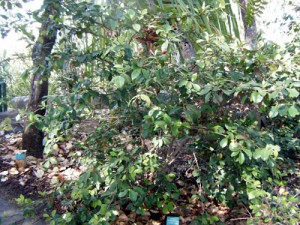
A walk through the lush native forests surrounding Thala Beach Lodge at this time of year will yield visitors a view of the Cedar Bay Cherry fruiting. This unique rainforest fruit tree bears bright red bulbous fruit that when ripe is deliciously sweet. It is historically known as a great source of ‘bush tucker’, and is also a favorite of nectar-loving native birds. Belonging to the Lilly Pilly family, the Cedar Bay Cherry grows in dry or lush coastal forested areas, and is just as likely to be found growing along dry creek beds and rocky beach fronts as it is in lush rainforest.
The Cedar Bay Cherry derives it’s name from a very special place further north from Thala on the Queensland Coast, where the tree is prevalent. Cedar Bay is nestled in the heart of the Wet Tropics, between the small townships of Bloomfield and Rossville. Inaccessible by road and protected under the Wet Tropics listing by the Queensland Parks and Wildlife Service, a permit must be obtained to venture into this virtually untouched paradise. Accessible on foot or by boat, those lucky enough to be able to explore this lush environment will find a rainforest that is centuries old, through which run freshwater streams that flow across the pristine white beach and feed into the sheltered blue waters of Cedar Bay.
Despite it’s namesake, the Cedar Bay Cherry can be found sporadically all along the Queensland coast, from as far south as Bundaberg, all the way to Cape York, and even throughout the Torres Strait and in some parts of Papua New Guinea. It more widely known as the Beach Cherry outside of Queensland, and is a close relative of the Brazilian Cherry, a South American native. that is used medicinally by South Americans to treat a wide range of ailments. Like the Cedar Bay Cherry, the Brazilian Cherry is delicious so is also used by South Americans to make various preserves and other traditional food stuffs.
